Crusader fortresses
All these castles (and the armor of the medieval knights!) Are strictly individual and unlike one another: each country has created its own style, which is peculiar only to its buildings. They also differ from each other in the status of their lords: the king, the prince or a simple petty baron, like that Picardian feudal lord named Robert de Clari, who owned a feud of only six hectares in size. They differ in the choice of location, whether they are in the mountains (castles Tarasp or Zion in Switzerland), on the seashore (for example, Carnarvon Castle in Wales), along the banks of rivers (Marienburg Castle in Poland) or in an open field (Sals Castle in the province of Roussillon). Even whether they are in a humid or temperate climate conducive to the growth of forests, as is the case with Cusy, or on the border of a rocky desert, like Crac des Chevaliers in Syria, influenced their architecture and appearance.
The castle of the knights-crusaders - the legendary Krak des Chevaliers.
However, in any case, fortified feudal castles delight us with their amazing power, regardless of whether they are in good condition or severely destroyed by inexorable time in the eight or nine centuries of their existence. And the arrogant landowner, who wanted to remove a pile of debris piled in the middle of his field, knows well what work it cost him, but the technology now is not at all what it was then, and ... how much labor it cost all these stones to deliver to him ?!
Again, although all the locks look different, the difference between them really existed, primarily because of their purpose. One thing is a castle - a dwelling for the seigneur, and quite another - a castle belonging to some spiritual-knightly order or the same king who wished to consolidate his power with his construction. This is a different scale of construction, and sometimes the speed with which these castles were built, and - perhaps the most important thing for the defense of the castle from the enemy no matter who it is - this is the garrison it contains.
Well, for the locals who lived in villages near the castle, he was a refuge, and a guarantor of security, and a source of income. In addition, the castle was the source of all the most interesting in the then gray and ordinary life. News, and, therefore, gossip and gossip. Although we are aware of the numerous peasant uprisings that took place in the Middle Ages, there are many other examples, from which it is clear that in many cases both the peasants who lived around the castles and their seniors who lived inside the castle walls made up one whole and even happened and acted together!
Yes, but how were these stone strongholds built, which even today fascinate us with their size and durability of the walls? Was it possible that the space aliens, to whom so today today some people attribute the authorship of the Egyptian pyramids? Of course not! Everything was much simpler and more complicated. For example, the feudal lord could not attract his serfs to the construction of the castle. Even if he really wanted it. Barshchina - that is, labor service in favor of the owner or owners of the castle was unchanged and limited to local customs: peasants could, for example, be forced to clean the castle moat or drag the logs out of the forest to build, but no more.
It turns out that free people, who had the right of free movement in the country, built castles and at the same time had a lot of them. Yes, yes, these were free people, artisans who should be paid regularly for their work, and the rural corvée remained only some help for the feudal lord, but no more. After all, it is clear that working with stone required real experts in their work, and where did they get from the peasants? Well, if the feudal lord wanted the work to go quickly, then besides the masons, you also had to hire handymen, who also needed a lot! For example, it is known that the construction of the castle of Beaumaris Castle in England was carried out very quickly - from 1278 to 1280 a year, but the work of 400 masons and 1000 handymen were used. Well, and if the seigneur could no longer pay, there was always work for stone craftsmen: somewhere nearby there could be a cathedral, a church, a city under construction, so their working hands were always required at that time!
Despite the Roman heritage in the stone business, most of the fortresses built from the 6th to the 10th centuries were made of wood. And only later does the stone begin to be used - initially in the form of small stones, but gradually larger and more regular shapes. This is the so-called rubble stone from which most European castles are built, although, for example, in Livonia, almost all castles were built from bricks. The vertical surfaces of the walls were made completely smooth, to prevent the enemy from finding any clues during the assault. Starting from the XI century, they will increasingly turn to brick: it is less expensive and provides greater strength to buildings during shelling. However, very often the builders had to be content with what was near the construction site, because the oxen team with a weight of two and a half tons was not able to master over a day more than 15 kilometers.
Castle Kusi in France.
Say what you like, and some of the castles erected at that far time are simply amazing. For example, the castle of Cousy in France was so great that the entrance to it was guarded by a cylindrical tower (donjon) with a height of 54 meters and a width of 31 meters. In addition, he was defended by as many as three fortress walls, the last of which completely encircled the town of Kusi. When they decided to blow up the castle in 1652, they only managed to lightly cover the walls with cracks! Forty years later, an earthquake expanded these cracks in the masonry, but the tower survived. At the end of the XIX century, some restoration work was undertaken. But in the 1917, the German army for some reason needed to destroy it to the ground, and this required 28 tons of the most modern explosives! This is how great and durable the castle was, although the Kusi family did not belong to the highest nobility. “Neither the king, nor the prince, nor the duke, nor the count — bear in mind: I am Sir Kusi,” was the motto of this arrogant family!
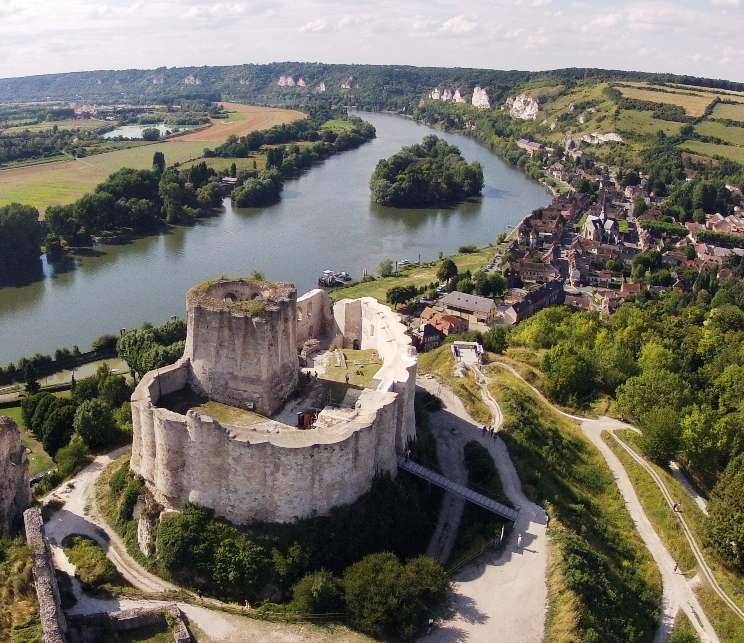
The well-preserved citadel and donjon of the Chateau-Gaillard castle seem to hang over the river valley.
Only a year, from 1196 to 1197, it took the English king Richard the Lionheart to build the Château-Gaillard fortress, which he was very proud of later. The castle was built according to a typical Norman project: an embankment surrounded by a moat, towered on the edge of a hill, on the very bank of the River Seine. The first bastion guarded the gates, and two high walls defended the donjon. The castle was supposed to serve as a support for the English possessions in Normandy, and that is why the French king Philip Augustus in 1203 took it to besiege. At first glance, he seemed to be impregnable, but the king of France began with the fact that he began to ravage the neighborhood and forced the locals (over a thousand people) to hide behind its walls. Soon there began a famine, and the defenders had to drive them away.
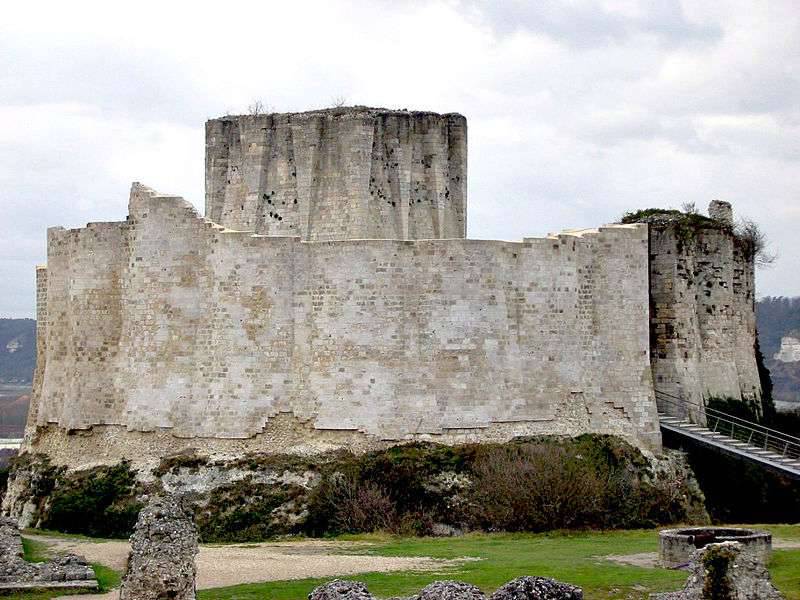
Donjon Castle Chateau-Gaillard.
Then Philip Augustus ordered the ditches to fall asleep, dig for mines and mine the towers. The first bastion fell, and the besieged took refuge in the central part. But one night the French penetrated into the very heart of the castle, and they got there through ... a latrine, which turned out to be too wide a hole! They lowered the drawbridge, panic began, and as a result, his garrison gave up, not even having time to hide in the donjon.
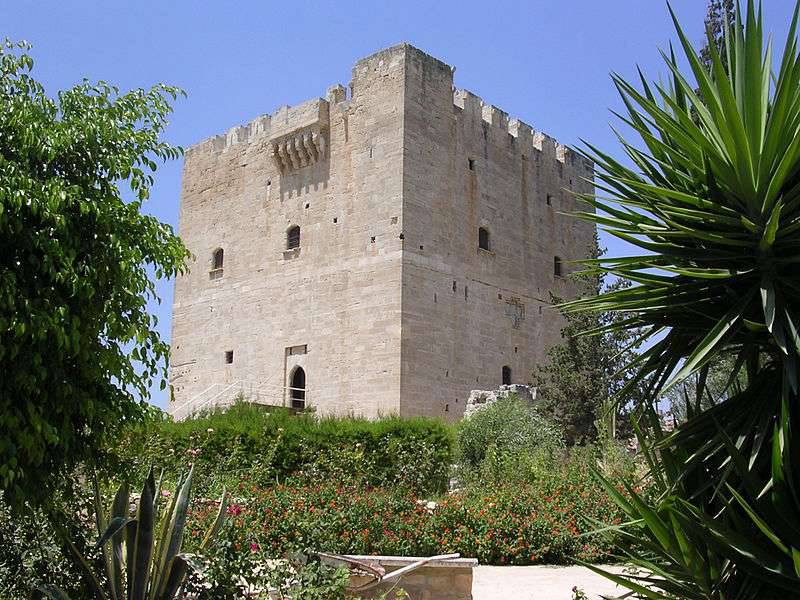
The Donjon of Kolossi Castle in Cyprus, built in 1210 by King Guy de Luisignan (http://www.touristmaker.com/cyprus/limassol-district)
As for the Crusaders' castles, in the Holy Land, which was also called the Outremer or “Lower Lands” in Europe (they were called that because they were depicted at the bottom of the European maps at that time, and, going to the East, the Crusaders moved from top to bottom "), They appeared almost as soon as the knights got there. They captured many castles and fortresses, and then rebuilt them, and among them, the castle Krak des Chevaliers or the “Castle of the Knights”, which is so interesting in all respects that it is necessary to tell about it in more detail.
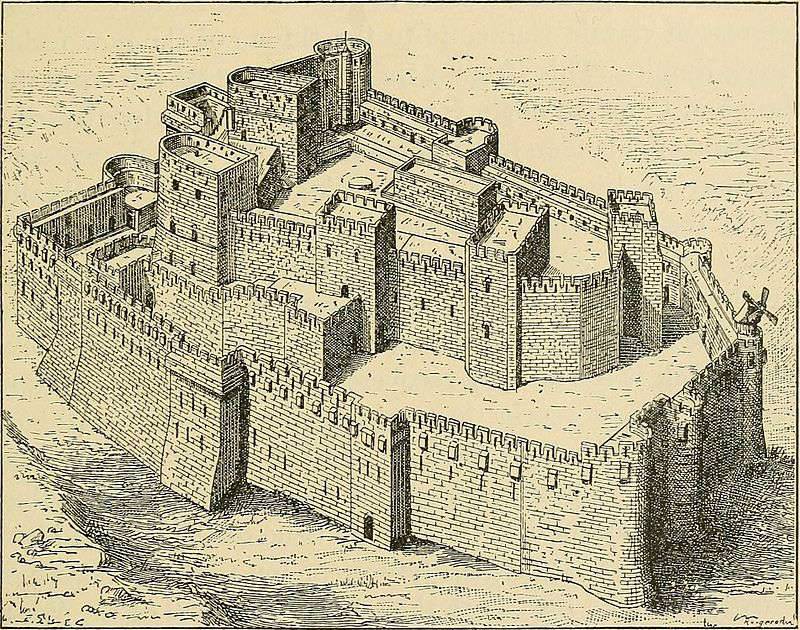
Reconstruction of the appearance of the castle Crac des Chevaliers 1914 of the year.
For the first time, the Crusaders captured him back in the 1099 year, but quickly left it, because they were in a hurry to go to Jerusalem. Once again, the fortress was beaten off by the Muslims already in the 1109 year, and in 1142-m was transferred to the Hospitallers. They strengthened the walls, rebuilt the barracks, the chapel, the kitchen with the mill, and even ... a multi-seat and also a stone toilet. Muslims launched numerous attacks, trying to regain the “fortress on the hill”, but each time it was unsuccessful.
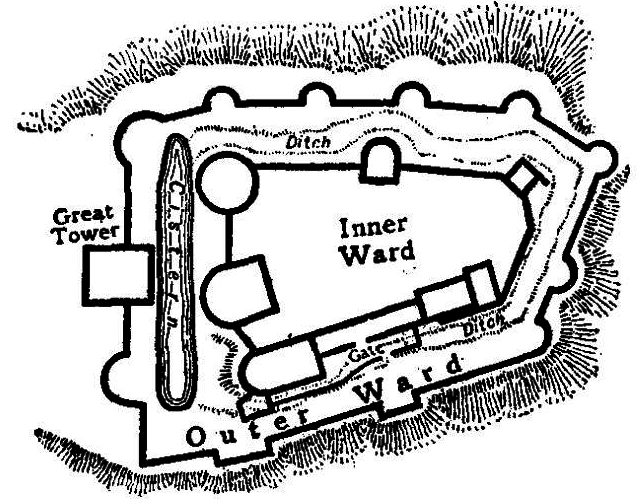
Plan of the castle Krak des Chevaliers.
As a result of the 1170 earthquake, the castle was damaged, and its construction style has changed significantly. In place of the rigor and simplicity of the Romanesque style came the refined gothic. In addition, at the end of the XII - the beginning of the XIII centuries, in Krak, not only were the chapels and separate towers destroyed by an earthquake rebuilt, but they were also fenced with a powerful external wall.
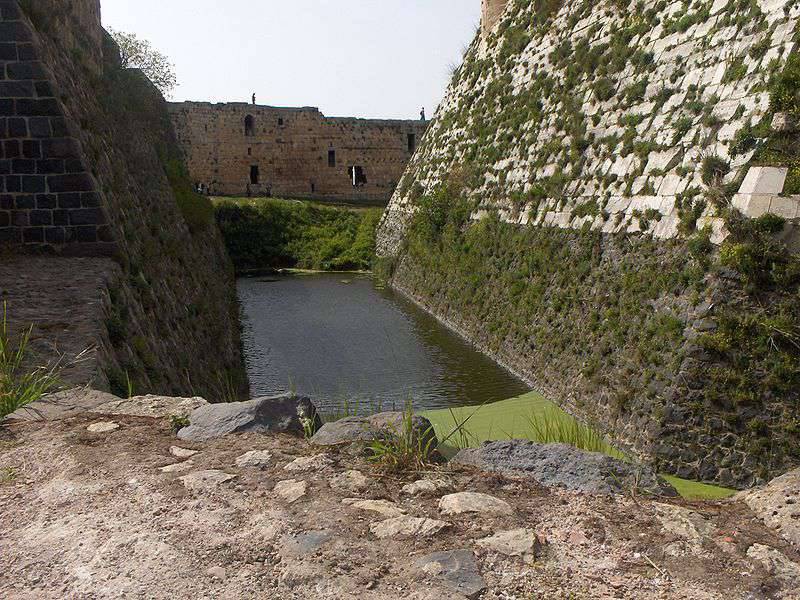
Berkil.
Bethel was built between the inclined buttress in the western part of the fortress and its outer wall - a deep body of water, which served not only as a water store, but also as additional protection from enemies. The size of the castle rooms is staggering. For example, it has a gallery - the 60-meter hall, built by Muslims and used by them only as a stable.
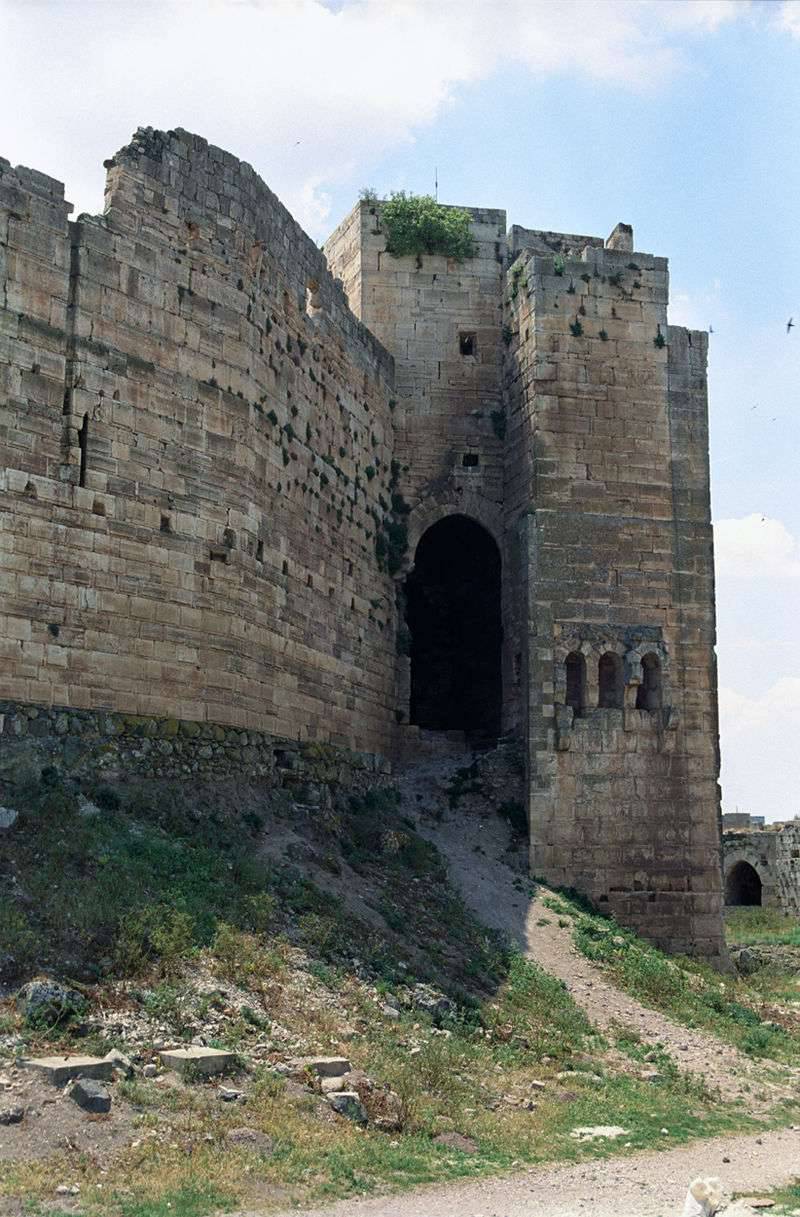
Gate to the castle.
Grain, olive oil, wine and supplies for horses were stored in the castle’s storerooms. In addition, the knights had numerous herds of cows, sheep and goats. The well inside the castle supplied the knights with water, in addition, water also entered it through an aqueduct from a natural source.
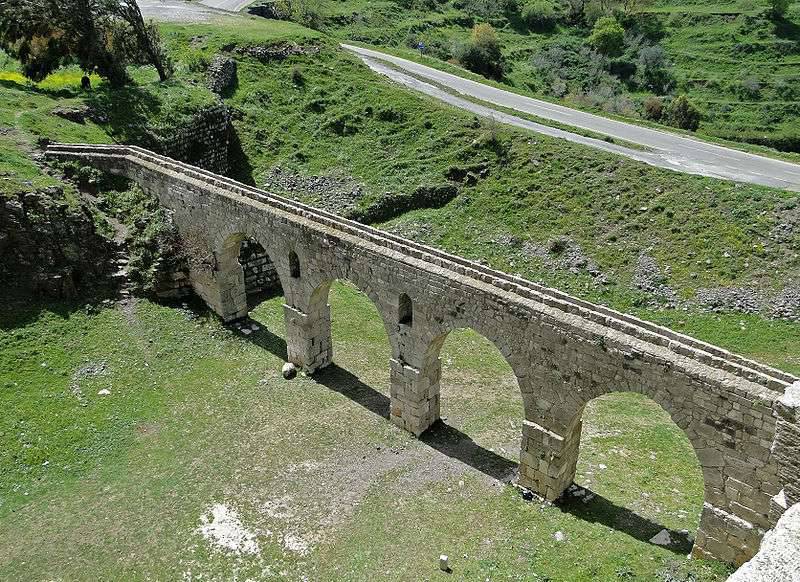
Aqueduct.
One of the earliest buildings of the castle - a chapel in the Romanesque style - was painted according to the Byzantine canon, although the inscriptions on the frescoes were in Latin. On the walls hung banners and war trophies, weapon dead knights ... and even harness their horses. After the castle was taken by Muslims, a mosque was built here.
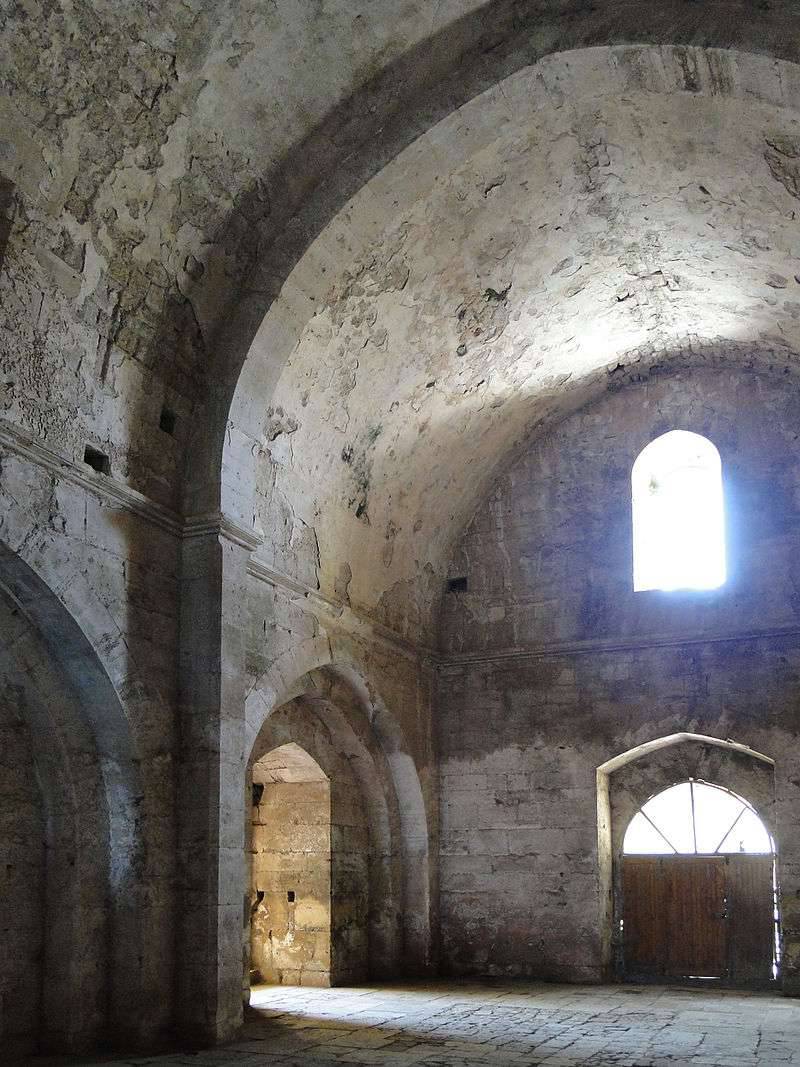
Chapel.
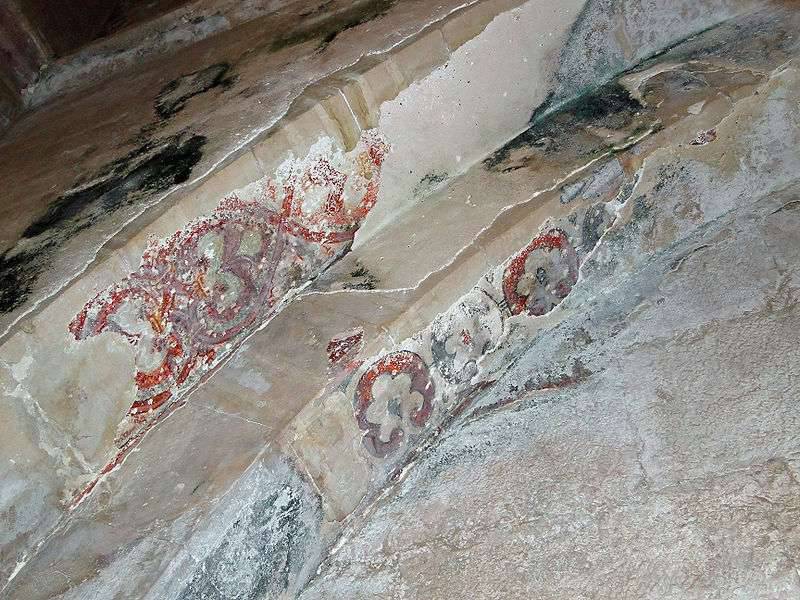
Preserved frescoes.
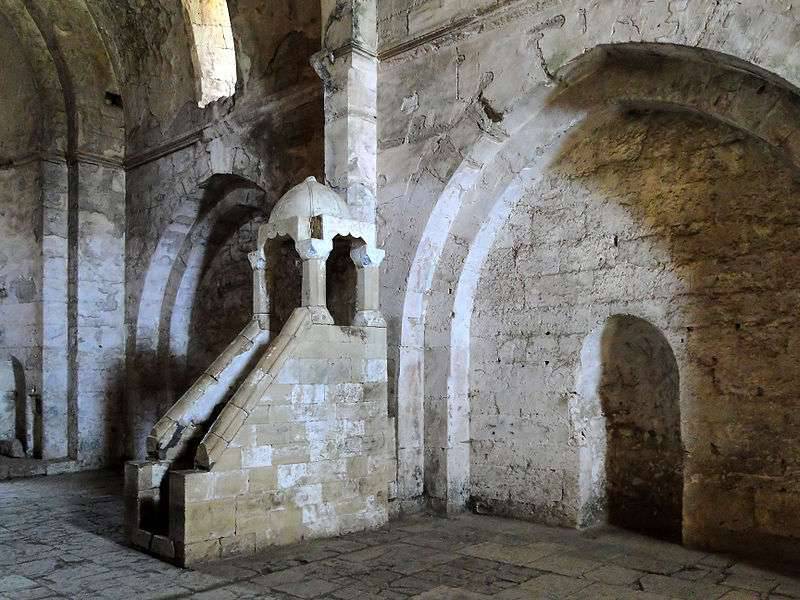
“And the verse of the Quran sounded from the minbar ...” When the Muslims captured Krak, they immediately transformed the chapel into a mosque and built a minbar in it.
By the beginning of the thirteenth century, the Krak fortress had become such a powerful fortification that within five years two thousand people could survive the siege.
About her security also says that she was the last refuge of the Crusaders in the East. Saladin himself, not once turned his attention to the high walls of Krak, for a long time did not decide on his assault, believing that the attack of this fortress would be tantamount to sending warriors to certain death. Therefore, he limited himself to destroying crops near the castle walls and appropriated the cattle of the crusaders, grazing nearby, which caused them great losses. Egyptian Sultan Beibars, who had beaten off all the fortifications of Europeans, like Saladin, was also aware that taking Krak by storm or starvation was almost impossible: powerful walls, thanks to which a relatively small number of garrisons could be defended in it, as well as huge food stocks created him well, just unprecedented "sustainability reserve". However, the Sultan still decided to storm the eastern part of his fortifications and, although he suffered heavy losses, he still managed to break through into the space between the outer and inner walls. But it became very difficult to take possession of the castle’s stronghold entirely. 29 March 1271, after the successful digging of the Sultan's warriors, fell into the very heart of the "Hospitaller's Nest". However, the small garrison did not surrender even after that, but took refuge from them in the most fortified place - the southern redoubt, where the main food reserves were stored.
Here in these dungeons everything was kept ...
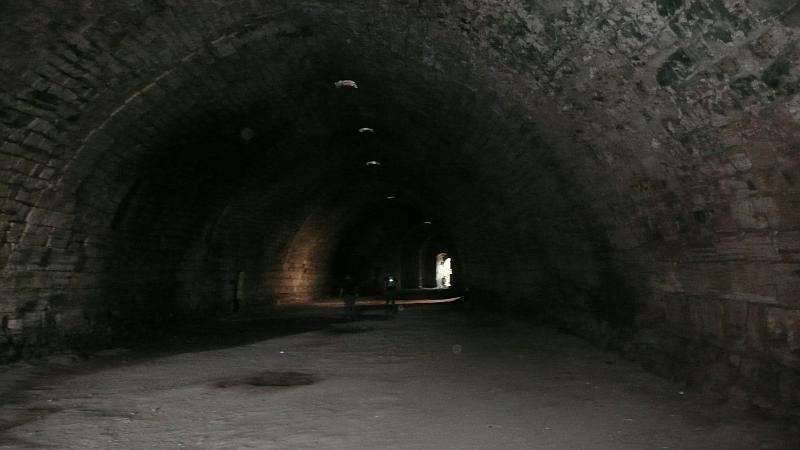
And they are just scary. After all, such a stratum of stones above your head.
Now, in order to lure them out of this cover, a trick was needed. It was made a letter allegedly from the Grand Master of the Order with the order of the surrender of the fortress. 8 April he was taken to the garrison, and her defenders had no choice but to fulfill the will of the "second father". Now the descendants of the soldiers of the Sultan's army adhere to a different version. According to them, the Arabs, allegedly disguised as Christian priests, came to the walls of the castle with prayers to protect them from the Muslim warriors. And when, they say, gullible hospitallers opened the gates to the “brethren of faith”, they snatched the weapon hidden under the clothes. Anyway, Krak was nevertheless taken. However, all the surviving knights Muslims saved their lives. After the invasion of the Mongols, the fortress fell into disrepair, and then was completely abandoned. There, as in many other forgotten fortresses, settled a small settlement.
South tower of the castle.
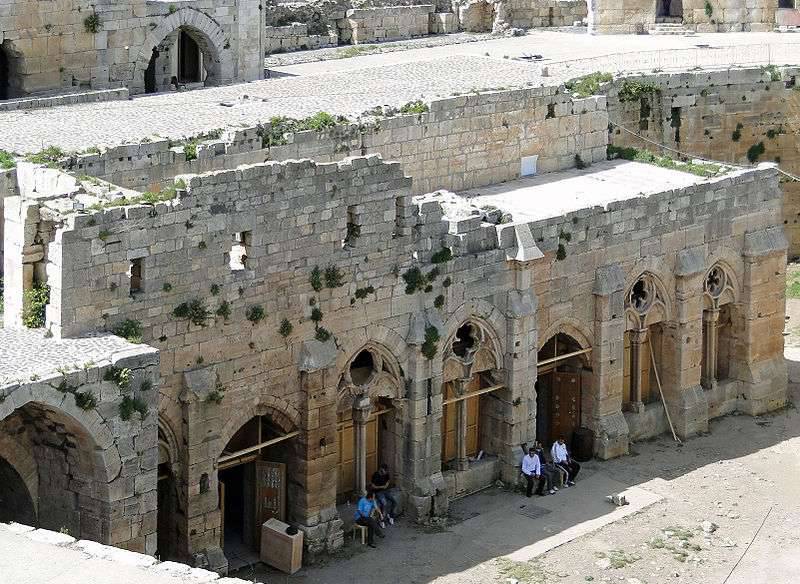
"Hall of Knights". In 1927, the restoration work began in the castle, so today, visitors can see the Knights Castle in almost all its former glory and splendor.
Order of the castle, built in Europe, also differed from all others as its size, and the fact that they instead of the usual chapel built a relatively large church that can accommodate all the knights brothers who spent time in her prayers. Under the refectory in the order's castles, the largest room was also allotted, since several hundred people (knights and sergeants of the order) had to eat at the same time, which never happened in those castles that belonged to a single feudal lord.
The battle towers in the order's castles usually tried to locate at its corners and built them specifically so that they would rise above the walls on one floor, which made it possible to bombard them not only around the area, but also the walls themselves. The design of the loopholes was such that it provided the shooters with both a significant sector of shelling and reliable protection against enemy shots. The height of the castle walls was comparable to the height of a modern three-four-storey building, and the thickness could be four or more meters. In some large castles there were several rows of walls, and the approaches to the outer walls were usually protected by moats and paling. In the crypt under the church floor, the fallen knights were buried, and the gravestones decorated their sculptural images of stone, made in full growth - effigii. A spacious church inside the castle served the knights for joint prayers and meetings. Donjon, “fortress in the fortress”, the largest and tallest tower in the castle - was the latest and most reliable stronghold for its defenders. For wine cellars, knights and, in particular, the Templars did not spare the place, because they used wine not only during table meals, but also as a medicine. The decoration of the refectory of the order castles was distinguished by asceticism and consisted of wooden tables and benches with the very minimum of decorations, since everything associated with bodily pleasures in spiritual and knightly orders was considered sinful and was forbidden. The living quarters of the Knights Brothers also did not differ in great luxury, as, by the way, the separate chambers of the commander of the castle garrison. It was assumed that all the time free from war knights should be carried out in military exercises, as well as fasting and praying.
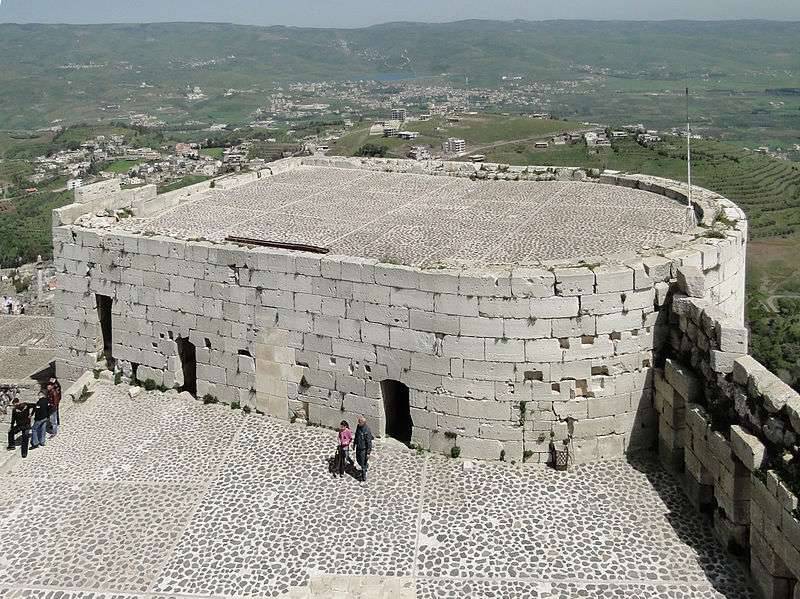
The southeast tower of the castle Krak des Chevaliers.
All over the top of the wall, an indoor combat passage with embrasures was usually used to fire at the enemy. Very often he was made so that he would stand out a little, and then he also made holes in the floor so that through them he could throw stones down and pour boiling water or hot tar. Spiral staircases in the towers of the castle also had a defensive value. They tried to twist so that the attackers wall was on the right, making it impossible to swing the sword.
West Tower.
West Tower and Aqueduct.
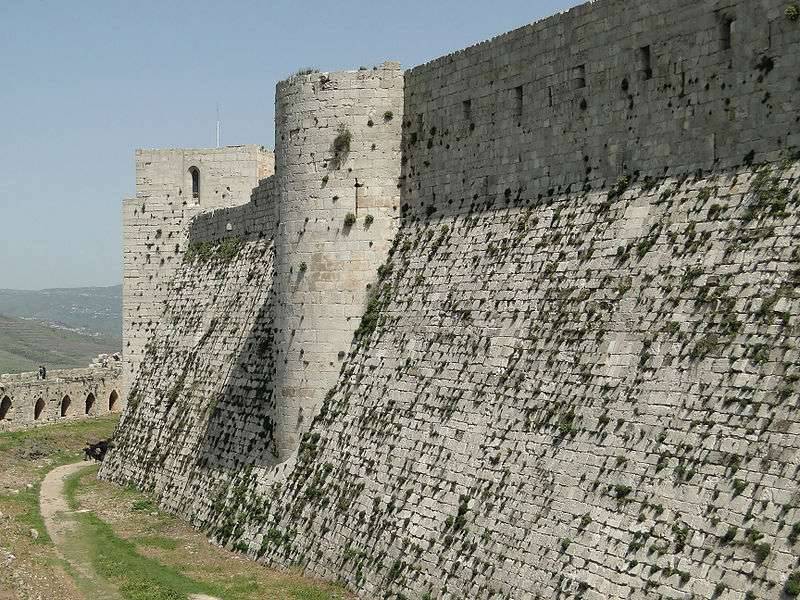
West side of the inner wall.
The Crusaders in the Holy Land used a variety of objects as fortifications, including Roman amphitheaters, basilicas and even cave monasteries! One of them was the monastery of Ayn Habis, which was a few caves dug by Byzantine monks right in the middle of a steep cliff in the valley of the Yarmuk River. For a long time no one knew where these monks made their secluded refuge until the Crusaders arrived in the valley. Those did not have time to build a strong fortress here, and they turned a cave monastery into it, connecting all its halls with wooden stairs and balustrades. Relying on him, they began to control the way from Damascus to Egypt and Arabia, which, of course, did not please the ruler of Damascus. In 1152, the Muslims attacked this mountain fortress, but could not take it and retreated, after which the king of Jerusalem sent a large garrison here.
In 1182, Saladin decided to seize Ain Habis at all costs, for which he sent to his assault an elite squad of warriors, who were undermined specialists, who proved themselves well during the sieges of other castles built by the Crusaders. The warriors seized the lower gallery of the monastery, after which a secret passage was dug up from one of its interior, through which they burst inside, and where the Europeans did not expect them at all. As a result, the fortress fell only five days after the beginning of the siege!
But the Crusaders decided to regain the monastery and began to besiege it, not only from below, but from above. In order to deprive the defenders of water, they began to dump large stones, which destroyed the catchment basin that fed the monastery with water, after which the Muslims surrendered.
The plan of the assault on the cave monastery of Ain Habis.
That is, the Crusaders were not only good warriors in terms of skills in sword and spear skills, but also understood architecture and hired intelligent engineers to build their castles. In a word, trusting in Christ, they did not shun at all the achievements of the then military science and technology!
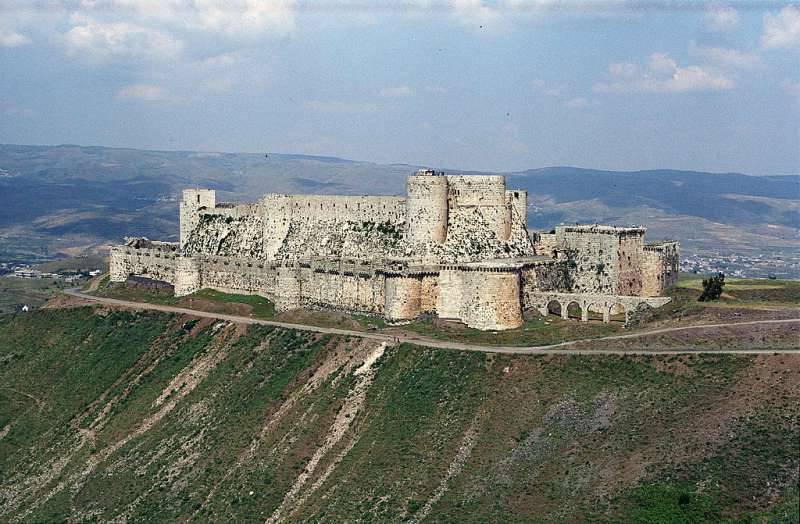
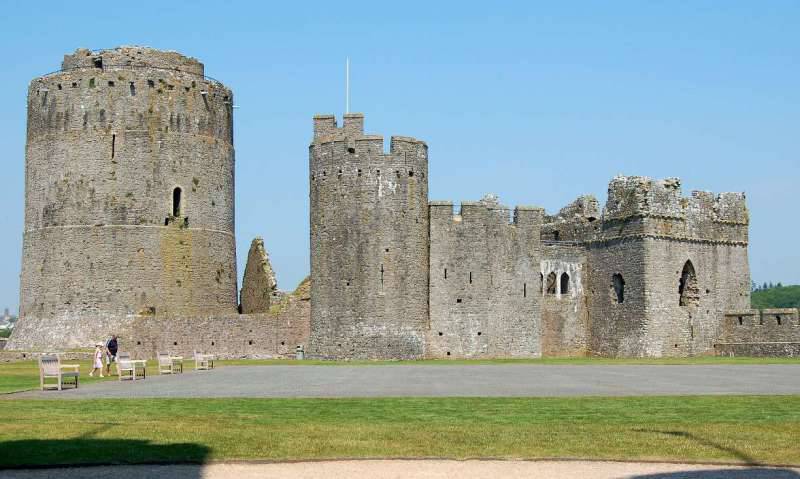
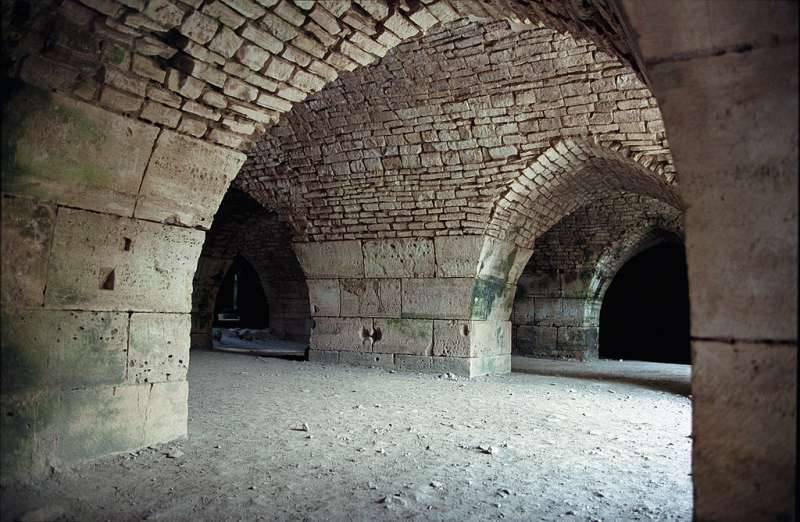
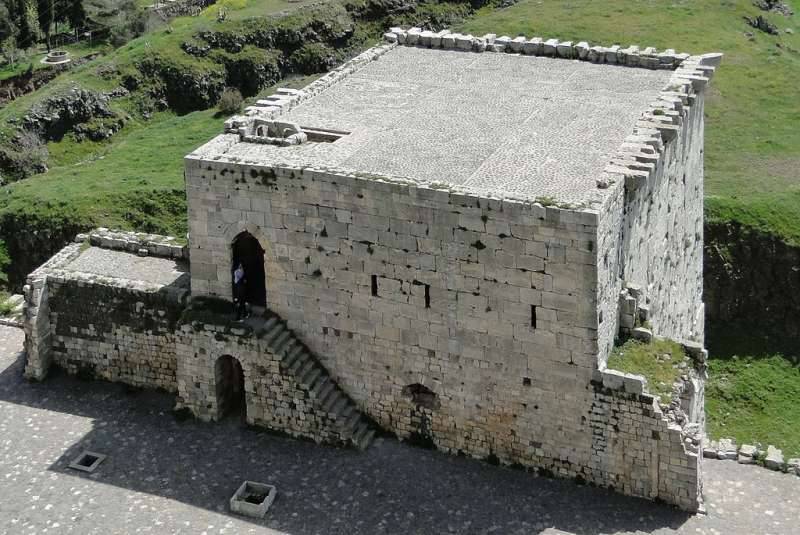
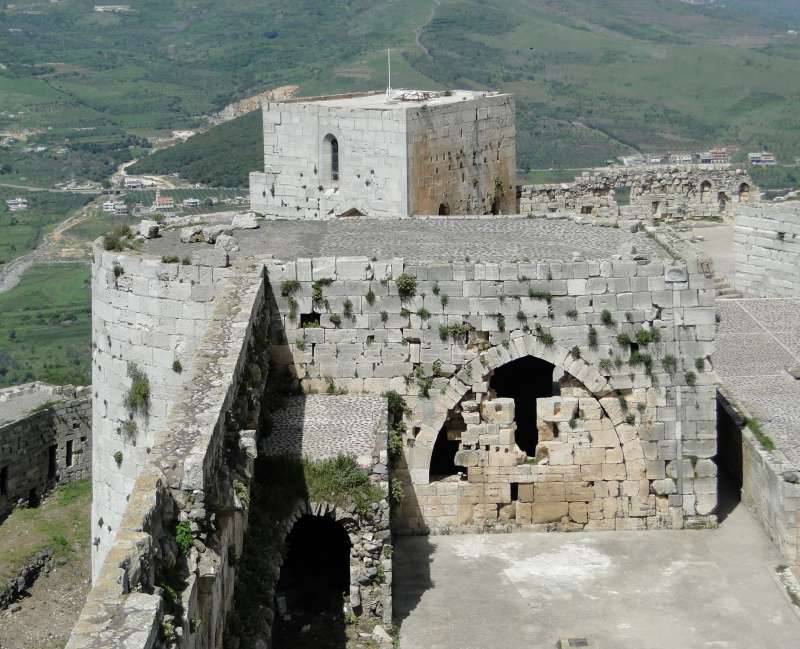
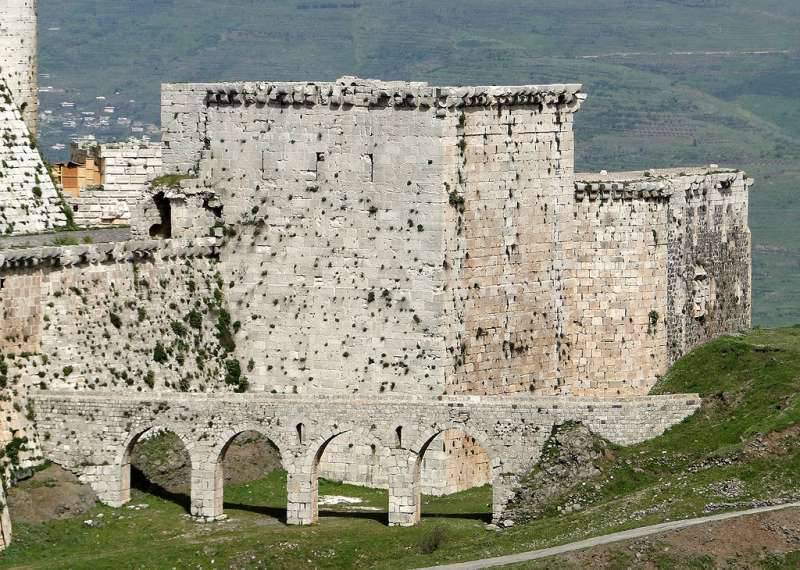
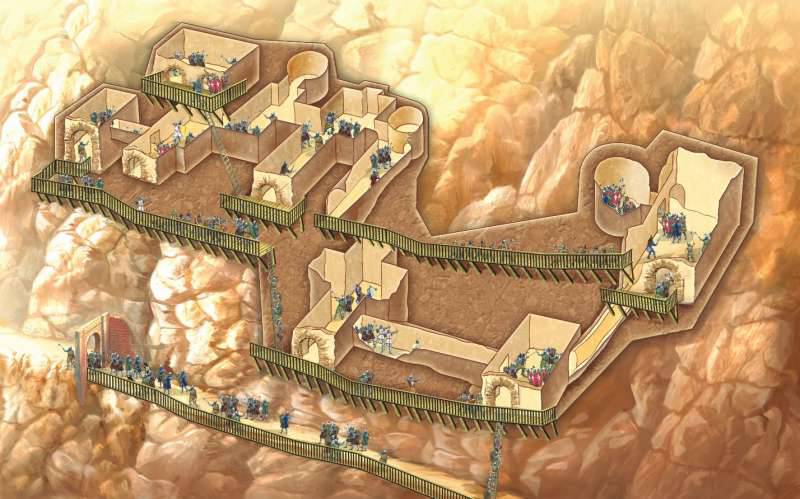
Information